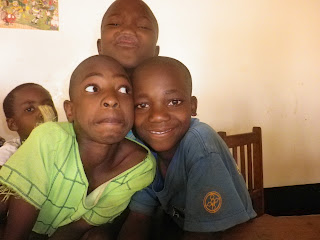Konklusionen fra rapporten:
The survey is conducted in connection with the termination of phase 1 of the PHC project. There have not been a similar survey at the beginning of phase 1, so it is not possible to speak about the development during this period. The report gives a snapshot of the health situation in the area and points out future focus items. The results will be shared with the villages and used in the future dialogue between the PHC and the villages about the health situation. Hopefully the results will be a helpful tool to motivate the VHCs and the citizens in the villages to improve their health situation. The results will also make the PHC stand stronger in the dialogue with the public authorities about the health situation in the area.The biggest surprise in the question about educational status was that only 2 % of the women have begun secondary school and none a higher education!
In the two villages without dispensaries (Kalila and Masolo) we found that less people consulted educated health persons compared with the other villages. The women in these 2 villages start later at ANC and have less visits compared with some of the other villages. Kalila and Masolo are between the villages were most women deliver out of health facilities and the deliveries are attended by TBAs and not educated health persons. This indicates that not everyone is travelling the longer way to find health facilities. As a whole the upwards of 15 % of the women say they have more than two hours to a dispensary. Based on these data the public authorities could be recommended to build more dispensaries. The question is if they get satisfying treatment at the dispensaries?
We found that there is not enough drugs available in the area. The findings can be used to make the public authorities improve the drug supply in the area.
On average all women get 4 children and lose one. The children are lost between 1 month and 1 year after the delivery. Prevention of child illness and education about symptoms of diseases of toddlers could be a part of the ANC program and the vaccination sessions where the PHC is in contact with a lot of women. To give the right education it is important to investigate the causes of the children's deaths.
Upwards of 60 % of the last born children were born out of health facilities. Every fourth of the women get a complication to the delivery of their children. This can be an argument to convince more women to deliver at health facilities.
Only 17 % of the women are currently using family planning. The most frequently mentioned reason not to use family planning is that they want more children. To get more women to use family planning is seems as one have to get the women to understand the rationale to have fewer children.
The percentage of immunized children in all the important vaccines (BCG, Polio 1,2,3, DPT 1,2,3 and measles) are all over 86 %.
To get a picture of the nutritional status for children over 2-3 years the PHC can perform health checks (hight and weight etc.) of the pupils during already scheduled visits at the primary schools in the villages in the project area, and in that way get a picture of the nutritional status of children in the area and check if there is need for improvement.
Only 30 % of the women purify their water in a way good enough to drink. It seems as they need to be better educated on how to get good drinking water, because 40 % say they use filtration, which is only cleaning the water for visible things.
More than 90 % of the women answer that they use mosquito bed-nets to prevent malaria and on average 87 % of the members of a household sleep under ITBNs. But you could ask why more than 70 % of the women still mention malaria as a main health problem in their household? The other frequently mentioned health problems are caused by poor hygienic standards. Only half of the households have a utensils rack and a garbage pit, two thirds of the households have a clothe line. Education in high hygienic standards and prevention of food- and water-borne diseases as well as malaria are still needed and should also be a focus area for the PHC in the future.
This survey has generally been very wide and the results create questions for further
investigation; what is the reasons for the children's death? At what age do the women give birth to
their children, and do use of family planning change this?
In addition the results can be valuable as baseline data for a possible future phase 2.
Pyha, en masse engelsk (og tænk at der er 22 flere i den samlede rapporten)... Det var det for denne gang. Slet ikke en dårlig måde at bruge sin sommerferie, synes jeg, også selvom bearbejdningen herhjemme i DK syntes at holde lidt hårdt... men hvem kan fortænke os i at synes, det var sjovere at arbejde under tropiske himmelstrøg!!










.JPG)













